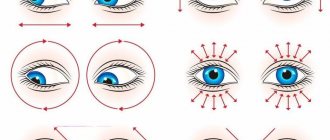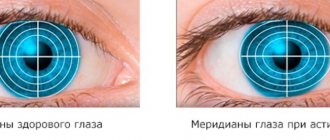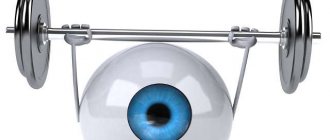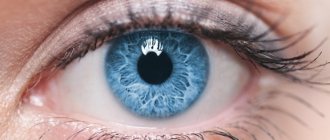Vision care room - a “gym” for the eyes
Within the Kronos Optics salons, there are several “gyms” - vision care rooms, where each device is designed to train certain visual functions.
Who should visit the Vision Care Office? Spoiler: most children!
Classes in the Vision Protection Room are indicated primarily for children, since all children are at risk for the progression of myopia (poor vision at long distances). It is important to understand that in childhood the rapid development of many eye diseases can be stopped. Part of the program to restore and improve vision is hardware treatment - regular eye training, which, together with correct vision correction with glasses, gives positive results. These trainings (as in good sports schools, by the way) are compiled according to individual programs.
Very often, training is also indicated for those children who do not wear glasses, because all modern schoolchildren, without exception, receive colossal visual stress. The widespread use of smartphones and tablet computers leads to a steadily increasing number of cases of acquired myopia every year.
Can adults visit hardware treatment rooms? Is it too late?
Adults also need training designed to maintain visual acuity, because modern people, as a rule, spend more than six hours a day at the computer and various gadgets.
How can I find out if I need to visit the Vision Care Office?
You can sign up for an eye test at any Kronos Optics salon convenient for you: Make an appointment with a doctor
The addresses of Kronos Optics salons where vision care offices operate can be found here. You can have your eyesight checked at any of the 76 salons.
What is treated at the Vision Care Office?
In the Vision Protection Rooms, hardware treatment of various refractive disorders is carried out: myopia (myopia), hypermetropia (farsightedness), amblyopia (lazy eye syndrome - when there are no organic reasons for the eye not to see, but vision is still reduced), violation accommodation (false myopia), strabismus.
What devices are used for eye training?
The most advanced technology is used for treatment. For example, the Sinoptofor
, used for the diagnosis, treatment and prevention of strabismus, has replaced outdated analogues and has already proven its effectiveness.
If the existence in the world of gadgets cannot be avoided, then to prevent myopia you can use training on the Visotronic ophthalmic simulator-relaxer.
. Such classes are indicated both for existing vision problems and for their prevention. “Visotronic” refers to those devices whose activities are suitable for both children and adults.
First of all, the Visotronic device is intended to train the eye muscles that provide accommodation, that is, the ability to see at different distances. Exercises on Visotronics are comfortable and absolutely safe. All device parameters are adjusted directly to you or your child. The process is monitored using a convenient display.
Magnetic therapy device
helps with inflammatory eye diseases, with hemorrhage in the eyes, is used for “lazy eye” syndrome and in combination with other devices to stop the progression of myopia.
There is also a laser therapy machine
- used for farsightedness and lazy eye syndrome.
Apparatus "Rucheek"
designed to train the eye muscles and the ability to see at different distances.
Semi-game techniques using computer programs are also widely used - “Pleoptics”, “Contour”, “Eye” and others. The form of the game helps to easily learn recommendations that help adapt the visual system to modern living conditions.
How long does treatment at the Vision Care Office last?
The minimum course of treatment in the Vision Protection Room is 10 procedures. 1 lesson lasts 30-40 minutes. The course is best repeated twice a year.
How much do classes in the Vision Care Room cost?
The price of one procedure using the Sinoptofor device is 199 rubles. On Vizotronika - 499 rubles. The cost of other procedures is from 120 to 200 rubles.
Report “Vision protection” for preschoolers
Report “Vision protection for preschool children”
1. Problems of visual impairment in preschool children. The influence of technological processes on vision
The goal of modern Russian education is the comprehensive development of the child, taking into account his age capabilities and individual characteristics while maintaining and promoting health
Our preschool institution, General Developmental Kindergarten No. 116, has created optimal conditions for the comprehensive development and promotion of children’s health. We tried to create the most comfortable conditions aimed at the development of preschoolers. And in this regard, any pedagogical technology should be health-saving!
This approach makes it possible to achieve high effectiveness of the educational process and forms value orientations among teachers and parents aimed at preserving and strengthening the health of students.
In our work we rely on statistical monitoring of children's health. We carefully study and study the results of monitoring, make the necessary amendments to the program of education and development of children, due to which we are guaranteed to provide an individual approach to each child; We create positive motivation among preschool teachers and parents of students.
We clearly understand that vision is one of the most important organs for the development of a child. This is a most valuable, but at the same time very fragile system of the human body. Therefore, already in preschool age it is necessary to take care of this organ. It is vision that allows a child to see, write, read, draw, and engage in various activities.
And our task, as children's specialists, is to help children maintain visual health, make the learning process and gaming processes as useful and effective as possible for the prevention of visual impairment. Help children with visual impairments improve their visual health. Among other things, one of the key tasks is to provide appropriate recommendations to parents to protect their child’s vision. Many of our students have problems with vision and posture. But a person’s posture is not only the beauty of his figure, it is the main influence on his health: impaired breathing and circulatory functions, impaired speech and motor development, impaired vision, impaired nervous system and other health abnormalities.
Very often, children with poor posture simultaneously suffer from speech impairment, myopia, and their gross and fine motor skills and speech breathing are underdeveloped.
Modern electronic devices can also harm the child’s vision if special rules for the use of computers, tablets and other devices are not followed, taking into account the child’s age and health status.
Of course, studying or playing on a tablet, computer or other electronic device contributes, to a certain extent, to the mental development of a child, but it is important to take care of physical health. But it is critically important to follow the rules that determine the possible amount of time that a child, at a given age, can spend on an electronic device without harm to health.
Therefore, we will also present recommendations on the use of modern gadgets in the process of covering the topic of vision protection in the current report.
Various visual impairments arise and develop unnoticed, especially in preschool children. There are sensations of heaviness, pain in the eyes, headache, small objects are less visible, and the eye muscles tense when reading. If you do not pay attention to these phenomena in time, various deviations from normal vision may develop.
The most common eye diseases are: myopia, farsightedness and astigmatism.
The main causes of these diseases are not only inaccurate focusing on the retina of the eye, depending on the condition of the lens, but also the muscle efforts that are exerted when looking at close or distant objects.
The cause of visual impairment may be:
- poor nutrition. Food should be rich in vitamins A and D, which affect vision;
- the lack of ultraviolet rays affects the vigilance of children;
- colds;
- decrease or increase in air temperature;
- irritation, anxiety, decreased immunity;
- stressful situations - all these factors affect the condition of the eyes and increase the possibility of their diseases.
- other reasons
We study and select effective pedagogical methods that allow children to develop correct ideas about health, as well as easily, in
a playful way
, instill and strengthen skills for the development and growth of a healthy body. Such methods include: pedagogical protective regimes, preventive visual gymnastics, physical education breaks in classes and other techniques.
In order to expand visual horizons, develop creative imagination and holistic (sensory-imaginative and intellectual) perception and knowledge of the world, our preschool institution actively uses a specially developed methodology by Vladimir Filippovich
Bazarny
, which eliminates early loss of vision, relieves physical and psycho-emotional tension in children, serves prevention of myopia, postural disorders, trains the vestibular apparatus.
The technique involves a playful form
, which allows preventive measures to protect vision to be carried out unobtrusively and interestingly for the child.
It is important to note that
play when working with preschool children is a powerful tool that allows you not only to solve educational problems and problems of protecting the child’s health, but also to involve the child directly in this process, to instill in children through play the correct attitudes and rules that contribute to their development. health and development, including prevention and visual health.
2. Prevention of vision in preschool children Methodology of Vladimir Filippovich Bazarny
Since in kindergarten, during the process of education and training, a significant load falls on the child’s visual perception, the task of the children’s teacher is to structure his work so that the children’s vision not only does not deteriorate, but, if possible, is restored. To do this, in the process of his work, the teacher can creatively introduce the principles of health development education by V.F. Bazarny.
The chosen methodology allows us to successfully solve the following problems:
1. Promote the normal and natural functioning of the eyes by relieving mental and physical stress;
2. Train your eyes with exercises;
3. Develop visual acuity, as well as visual memory, reaction speed;
4. Preserve children's vision.
In the monograph of Professor V.F. Bazarny’s “Vision in Children: Problems of Development” outlines the concept of health-developing and health-strengthening education for preschool children.
The concept involves 5 basic principles that a child specialist can use in his work:
First principle:
constructing classes with children in the mode of “visual horizons” and moving objects, that is, the didactic material is as far away from the children as possible and is in motion in relation to them and vice versa, the children move in relation to the material. Whenever possible, classes are conducted in a natural ecological environment.
Second principle:
Special classes are held 2-3 times a week to increase the vision reserve of children.
Third principle:
To train the muscles of the visual organs and prevent myopia (myopia), 1-2 times a day children perform exercises accompanied by movements of the eyes and head along a clearly programmed trajectory.
Fourth principle
: all classes (regardless of the section of the program) are conducted in the “dynamic pose” mode, that is, periodic change of position: “sitting”, “standing”, the “lying” pose is also used.
Fifth principle
: use of the “Ecological Primer” when introducing children to letters and learning to read. “Ecological Primer” according to Bazarny is a plot of nature measuring at least two meters. Heroes of famous children's fairy tales, animals, birds bring letters to children and introduce them to them.
A distinctive feature of the teaching method in far vision mode is that the objects being studied are located at the maximum distance from the children. A “teacher line” is outlined, that is, a place from which benefits are shown to children. Children sit at a certain distance from the “teacher line” in accordance with their visual acuity.
All classes have the following structure:
1 part:
examination of a plot picture, where the largest objects are no more than 2-3 centimeters, and the smallest ones are no less than 10 mm.
Part 2:
looking at pictures of objects. The sizes of the objects depicted in the pictures are 3-5 centimeters or less. In this part of the lesson, the technique of moving objects is used.
Part 3:
dynamic pause, which is always carried out while standing.
Children complete all tasks willingly and with great interest. By periodically changing positions “sitting” and “standing”, the child does not feel tired. Constantly relieving physical and mental stress in children, it is necessary to remember that relaxation leads to improved vision. For these purposes, you can perform swaying exercises with children, standing in front of the window at a distance of 30-40 cm and smoothly transferring the body weight either to the left or to the right leg, while the head remains motionless relative to the shoulders and torso. At the same time, you can look at some stationary object in the distance. Children can perform this exercise after drawing, modeling, or appliqué classes.
Various options are possible, we will talk about them in the practical block of our master class.
3.
Recommendations of ophthalmologists for the prevention of visual disorders in preschool children
The greatest load on vision occurs during compulsory classes, and therefore control over their duration and rational construction is very important. Moreover, the established duration of classes - 25 minutes for the senior group and 30 minutes for the preparatory group for school - does not correspond to the functional state of the children’s body. With such a load, children, along with a deterioration in certain indicators of the body (pulse, breathing, muscle strength), also experience a decline in visual functions. The deterioration of these indicators continues even after a 10-minute break. Daily repeated decrease in visual functions under the influence of activities can contribute to the development of visual disorders. And, above all, this applies to writing, counting, and reading, which require a lot of eye strain. In this regard, it is advisable to follow a number of recommendations.
First of all, you should limit the duration of activities associated with eye accommodation strain. This can be achieved by timely changing different types of activities during classes. Purely visual work should not exceed 5-10 minutes in the junior group of kindergarten and 15-20 minutes in the senior and preparatory school groups. After such a duration of classes, it is important to switch the children’s attention to activities that are not associated with eye strain (retelling what they have read, reading poetry, didactic games, etc.). If for some reason it is impossible to change the nature of the activity itself, then it is necessary to provide a 2-3-minute physical education break.
An alternation of activities when the first and the next are of the same type and require static and visual tension is also unfavorable for vision. It is advisable that the second lesson be associated with physical activity. This could be gymnastics or music.
It is especially important to increase the effectiveness of the 10-minute break between two classes. To do this, you can invite the children, at the end of the first lesson, to go to the window and look into the distance for 2-3 minutes. It is advisable to repeat the same thing after finishing the second lesson. Experience shows that such a simple exercise, if carried out daily, helps restore the level of visual functions, the temporary decline of which is inevitable under the influence of exercise. Physical exercise is also of great importance.
Proper hygienic organization of activities at home is important for protecting children's vision. At home, children especially love to draw, sculpt, and at older preschool age, read, write, and perform various tasks with children's construction sets. These activities, against the background of high static stress, require constant active participation of vision. Therefore, parents should monitor the nature of their child’s activities at home.
First of all, the total duration of home activities during the day should not exceed 40 minutes at the age of 3 to 5 years and 1 hour at 6-7 years. It is desirable that children study both in the first and second half of the day and that between morning and evening classes there is a sufficient amount of time for active games, being outdoors, and working.
It should be emphasized once again that even at home, the same type of activities associated with eye strain should not be long.
Therefore, it is important to promptly switch children to a more active and less visually stressful activity. If monotonous activities continue, parents should interrupt them every 10-15 minutes to rest. Children should be given the opportunity to walk or run around the room, do some physical exercises, and to relax accommodation, go to the window and look into the distance.
4. Recommendations
Colleagues, in conclusion, we would like to make a number of recommendations:
During the first twelve years of a child’s life, his visual organs develop intensively. During this period, the eyes are especially susceptible to the negative influence of numerous factors, such as increased stress (computer, reading, TV), injuries, infections, unfavorable environment, and many others.
How can you help a developing child’s body resist such influences from the external environment and prevent the child’s vision from deteriorating?
- Any physical activity helps the baby's eyes work better. Organize your children to move more and play outdoor games. Playing sports will also benefit them.
- Be sure to monitor your child's posture. After all, if a child sits with a “crooked” back, his blood supply to the brain is disrupted, which, in turn, provokes vision problems.
- Do not allow your child to sit for a long time without interruption at the table with a construction set or blocks.
- And one more important point: to train your baby’s vision, it is useful to play with bright, moving toys that spin, jump and roll.
- Do eye exercises with your child regularly. Turn it into a daily fun game of Fun Week!
LITERATURE
Bazarny V.F. “Vision in children: Problems of development” - Novosibirsk: Nauka SO, 1991.
“Creating conditions for the protection and restoration of vision” (methodological development of a preschool educational institution)
Magazine "Healthy Preschooler"
Site materials https://www.detskiysad.ru/
Article "Protecting children's vision."
Ophthalmologist at Children's Clinic No. 4 Nadezhda Alekseevna Tyurenkova.
Vision protection is a complex of therapeutic, hygienic, educational and educational measures aimed at maintaining the normal functioning of the eye and preventing further vision loss. A set of necessary conditions that will contribute to the child’s well-being, maintaining a high level of the functional state of the nervous system and, therefore, will have a positive effect on the growth processes and development of both individual body functions, including visual ones, and the entire body:
- proper alternation during the day of different types of activities, wakefulness and rest;
— sufficient physical activity;
- maximum exposure to air;
— timely and rational nutrition;
- systematic hardening.
Compliance with doctor's instructions:
- follow the instructions prescribed by your doctor;
- if you are prescribed glasses, purchase them as quickly as possible and teach your child to use them (glasses, even sunglasses, can only be prescribed by a doctor);
- don’t forget your glasses at home;
— teach your child to observe hygiene when wearing glasses (wash hands before contacting glasses; treat with a special solution (or just water and soap) when they become dirty, and preferably every evening);
— Have your child’s vision checked by an ophthalmologist annually.
Protecting your eyes from damage and injury:
— the child’s eyes should be protected from accidental injury by teaching the youngest children the basics of safety (careful handling of sharp objects, fire, chemical liquids, etc.);
- protect your baby’s eyes from sand and dust, trying not to walk with him for a long time in windy, dry weather (if sand, dust, or chemicals get into his eyes, rinse his eyes with clean water and contact a specialist);
- if your eyes are injured, you should not rinse them; you should cover them with a clean handkerchief and immediately seek medical help.
Vision hygiene
implies protecting the eyes from excessive stress and providing conditions that are optimal for the normal development and unimpeded functioning of the visual apparatus:
Rules for organizing visual work:
— furniture
should correspond to the height of the child; with the correct position of the body, the distance between the child’s eyes and the working surface is 30-35 cm, which provides the best conditions for visual work.
— correct landing
at the table not only reduces general fatigue, prevents poor posture, but also helps preserve vision;
— ensuring good lighting
: combination of artificial and natural lighting (harmless?); additional lighting must be used not only in the evening, but also in the morning and daytime, especially in the autumn-winter period of the year; it is very good if the windows of the children's room are oriented to the south, southeast and east; if there is an open area in front of the windows; Windows in a children's room should only be covered with light curtains along the edges of the window opening (10-15 cm beyond its edge), but under no circumstances should the upper part of the window be covered; dustiness and contamination of windows, especially those facing the street, lead to a decrease in illumination in the room by up to 40%;
it is light that
is of paramount importance for the prevention of visual disorders;
classes, games, watching TV in the twilight leads to excessive eye strain and may be one of the reasons for its deterioration - the place for studying should be in the brightest part of the room, closer to the light-carrying wall, place it at a distance of 0.5 m from the window so, so that the light falls from the left;
- you can read while sitting in a chair (sofa), but only in a comfortable position; you should not read while lying down;
— you cannot read or use a smartphone (tablet) in a moving vehicle;
- You should also work at the computer in good daylight or with the overhead lights on.
- promptly switch children to a more active and less visually straining activity (children should be given the opportunity to walk or run around the room, do several exercises to relieve visual strain).
Rules for watching TV:
- children should watch only special children's programs;
— the duration of continuous viewing should not exceed 30 minutes;
— the optimal distance for vision is from 2.0 to 5.5 m from the screen (if the child’s visual acuity is very low, consult a doctor about individual selection of the distance);
- the child should sit not on the side, but directly in front of the screen;
— in the room when watching TV there can be normal natural or artificial lighting; in the dark, watching TV is completely prohibited.
COMPLETED BASED ON THE LECTURE “EVISION PROTECTION EVENTS” Belarusian State Pedagogical University named after. M. Tanka.
How to maintain healthy vision? Practical recommendations
- Infectious diseases, against the background of which significant intoxication of the body occurs and, as a result, vision deterioration.
- Overwork, in which the body cannot fully regulate the functioning of the nervous system, as a result of which changes in blood circulation occur and the eyes are among the first to suffer.
- Slagging of the body, due to which the vitreous body of the eyes can be damaged (it must be absolutely transparent, and toxins and salts accumulating in the body can lead to a significant decrease in transparency).
- Concomitant somatic diseases (arterial hypertension, diabetes mellitus), which impair blood supply to the eyes, reduce the transparency of the vitreous body, and damage the optic nerve.
Preventative maintenance of eye health
Everyone knows that diseases are much easier to prevent than to treat.
This statement especially applies to eye diseases, so it is best to engage in prevention so that later you do not have to resort to expensive procedures. There are several important points that will help keep your eyes healthy for as long as possible.
- Watch your diet
What you eat can also affect the quality of your vision, and at any age. The right habits help you stay healthy longer. First of all, you should eat more vegetables, grains and fruits, and significantly reduce your sugar intake. Additionally, to maintain eye health, you can take nutraceuticals to protect your vision on all fronts.
- Physical activity
Walk more often, spend time outdoors, and engage in active sports. This is not the first time that scientists have proven that regular walks help slow the progression of myopia.
- Healthy sleep
The correct daily routine is the key not only to productivity, but also to good vision. Fatigue and lack of healthy sleep lead to various eye diseases and increased fatigue. Try to sleep at least 7-8 hours and not disrupt your established routine.
- Reading, computers and smartphones, watching TV
Avoid reading books in low light or lying down. Try to take a break for a few minutes every 45-50 minutes after reading a book or magazine. TV should also be viewed at a sufficient distance - five times the diagonal of your TV.
Computers and smartphones deserve special mention, with which almost everyone interacts. The smaller the monitor or phone display, the closer you bring it to your eyes - this can cause deterioration in eye health. You need to take mandatory breaks every 30-40 minutes.
Consultation for educators: “Prevention of visual impairment in preschool children”
| Topic of consultation : “Prevention of visual impairment in preschool children” |
Relevance:
Vision is one of the main sense organs, which provides a person with up to 90% of information about the world around him. But the visual system is very fragile and vulnerable, especially in childhood. Even 10 years ago, doctors talked about decreased vision in primary school children, but now there are many children with impaired vision in preschool institutions.
An analysis of the incidence of pupils in our institution over the past 3 years has shown that the number of pupils with visual impairments is increasing every year.
In this regard, one of the tasks of the annual plan for this academic year is:
— to intensify the use of methods for the prevention of visual impairment in pupils
Causes of visual impairment in children.
1. Increased eye strain (no
restrictions on watching TV and time spent at the computer)
on the part of parents
- Watching television for a long time causes visual fatigue, which is accompanied by impaired blood supply to the tissues of the eye, tension of the eye muscles, which ultimately leads to decreased vision.
—
No matter what modern means of protection a computer monitor has, prolonged exposure to the screen negatively affects vision. As a result of prolonged, continuous gaze at the monitor screen, the eye muscles are in constant tension, which leads to visual fatigue.
Many children sit for hours in front of the monitor, completely absorbed in computer games. All kinds of “shooters” with flashing light and color effects are especially harmful to vision.
-Long activities or games associated with eye strain.
2. Incorrect sitting position at the table when performing visual work.
Incorrect posture - stooping, curvature of the spine - lead to increased tension in the external and internal muscles of the eye, as well as the muscles of the neck and spine.
As a result, the eyes “work” under overload and quickly get tired. In addition, constant tension of various muscle groups disrupts the blood circulation in the eyes, which contributes to “wear and tear” of the eyes and the appearance or progression of eye diseases.
3. Insufficient workplace lighting
.
All visual functions decline sharply in low light conditions.
4.Decreased immunity, frequent infectious or inflammatory eye diseases.
These are styes, conjunctivitis and other eye problems.
The causes of conjunctivitis can be bacteria, viruses that cause acute respiratory infections, sore throat.
5.Adverse environmental effects on the eyes.
Solar radiation, poor ecology, dust, chlorinated water negatively affect the organ of vision. If a child stares at the sun for a long time, at welding sparks, is constantly exposed to debris and sand getting into his eyes, and endures microtrauma to the eyes, which can occur every day, there is a high probability that in the near future the child will begin to have vision problems.
6. Lack of vitamins,
important for vision, in the diet can also cause visual impairment in children.
7. Poor visual hygiene
Prevention of visual impairment in children.
- Rational organization of visual work;
Reasonable visual load
.
Like any human organ, the eyes, from excessive effort and tension, get tired and reduce the efficiency of their work.
-Same type of activities associated with eye strain should be interrupted every 10-15 minutes to rest the eyes.
— It is advisable to reduce the time of games that promote close viewing (chess, checkers, puzzles, etc.).
-The continuous duration of watching a TV program in the junior and middle groups is no more than 20 minutes, in the senior and preparatory groups - no more than 30 minutes.
- It is necessary to ensure a sufficient distance from the computer monitor - 40-60 cm, and from the television screen - 2-3 meters.
- Compliance with the light regime
Workplace lighting
To prevent overwork or fatigue of the child, it is very important to observe the light regime.
The work surface should be illuminated as follows: the light source must be located in front and on the opposite side of the leading hand. The light should always be soft (frosted lamp), not harsh on the eyes, but evenly illuminating the place of study. Exceptions include looking at pictures or reading books; in this case, the light source can be located on any side, the main thing is that it evenly illuminates the work surface and does not blind the eyes. It is necessary to maintain the level of natural light for the entire time the child is in play activities.
3. Formation of the skill in children of correct posture during visual work
You need to sit straight, leaning on the back of the chair, tilting your head slightly forward, your arms resting freely on the table, your elbows do not hang down, your legs rest with your entire feet on the floor or a bench. The chair is pushed 3-5 cm under the chair. It is important to teach your child to control his own position. So, you can check the distance from the eyes to a book or drawing with your hand: place your hand, bent at the elbow, on the table, your fingertips touch your temple, your fist should pass freely between the table and your chest, your shoulder blades touch the back of the chair.
4. Balanced physical activity and fresh air
To preserve vision, fresh air is absolutely necessary, which the child must receive constantly. The child should spend at least 1.5-2 hours a day outside. Moreover, all this time he should not sit on a bench with a book, but rather walk, run, and move more.
5.
A varied, nutritious diet rich in proteins and vitamins.
For keen eyes, foods high in vitamins A and C are useful. These are cottage cheese, meat, kefir, fish, carrots, apples, dried apricots, blueberries, currants and lemons. In the off-season, do not deny yourself and your children pharmacy vitamin and mineral complexes for the eyes.
7. Maintain eye hygiene
The main measures to prevent the spread of infectious eye diseases are personal hygiene, individual towels, and bed linen.
8.Use of visual aids, methodological textbooks and books that have good quality of design, complying with sanitary standards and rules
9. Formation of the habit of performing exercises aimed at relieving visual fatigue
in kindergarten and at home.
The purpose of visual gymnastics:
- include in dynamic work the eye muscles that are inactive when performing tasks, and vice versa - relax those eye muscles that bear the main load;
- to form in children ideas about the need to take care of their health and the importance of vision.
Gymnastics for the eyes improves the circulation of blood and intraocular fluid of the eyes, strengthens the extraocular muscles of the eyes, promotes good quality vision at different distances, relieves visual tension, increases visual performance, improves blood circulation and helps prevent visual impairment and the development of eye diseases.
General rules for visual gymnastics:
- fixed head position. It is necessary in order to force the extraocular muscles to work; if this condition is not met, then the muscles of the neck work, but not the eyes;
- the duration of visual gymnastics is 2-3 minutes in the younger and middle groups, 4-5 minutes in the older groups;
- the choice of visual exercises for classes is determined by the nature and amount of intellectual tension, the amount of motor activity, the intensity of visual work, as well as the type of lesson.
- After completing the exercise, stretch well, yawn heartily and blink frequently.
A set of gymnastics exercises for the eyes
1.Blink quickly, close your eyes and sit quietly, slowly counting to 5. Repeat 4-5 times.
2. Close your eyes tightly (counting to 3), open them and look into the distance (counting to 5). Repeat 4-5 times.
3.Extend your right arm forward. Follow with your eyes, without turning your head, the slow movements of the index finger of your outstretched hand to the left and right, up and down. Repeat 4-5 times.
4.Look at the index finger of your outstretched hand for the count of 1-4, then move your gaze into the distance for the count of 1-6. Repeat 4-5 times.
5. At an average pace, make 3-4 circular movements with the eyeballs to the right side, and the same amount to the left. Relax your eye muscles and look into the distance while counting 1-6. Repeat 1-2 times.
6.Performed while sitting. Leaning back, take a deep breath, then, leaning forward, exhale. Repeat 5-6 times.
7.Performed while sitting. Lean back in your chair, close your eyelids, close your eyes tightly, open your eyelids. Repeat 5-6 times.
8.Performed while sitting. Hands on your waist, turn your head to the right, look at the elbow of your right hand; turn your head to the left, look at the elbow of your left hand, return to the starting position. Repeat 5-6 times.
9.Performed while sitting. Raise your eyes upward, make circular movements with them clockwise, then make circular movements with them counterclockwise. Repeat 5-6 times.
10.Performed while sitting. Hands forward, look at your fingertips, raise your hands up (inhale), follow your hands with your eyes without raising your head, lower your hands (exhale). Repeat 4-5 times.
Physical exercises
1. All week in order, the eyes do exercises. On Monday, when they wake up, their eyes will smile at the sun, they will look down at the grass and back to the heights.
Raise your eyes up;
lower them down, head motionless; (relieves eye strain). 2. On Tuesday, the eyes watch, They look here and there, They walk to the left, they walk to the right They will never get tired.
Turn your eyes to the right side and then to the left, head motionless;
(relieves eye strain). 3. On Wednesday we play blind man's buff, close our eyes tightly.
One, two, three, four, five, Let's open our eyes. We close our eyes and open it. So we continue the game. Close your eyes tightly, count to five and open your eyes wide;
(an exercise to relieve eye strain). 4. On Thursdays we look into the distance, We don’t feel sorry for this time, What’s near and what’s in the distance Our eyes must see.
Look straight ahead, place your finger at a distance of 25-30 cm from your eyes, turn your gaze to the tip of your finger and look at it, lower your hand.
(Strengthens the eye muscles and improves their coordination). 5. On Friday we didn’t yawn. Our eyes ran around in circles.
Stop, and again run in the other direction. Raise your eyes up, right, down, left and up;
and back: left, down, right and up again; (improves complex eye movements). 6. Even though Saturday is a day off, We are not lazy with you.
We look for corners, so that the pupils run. Look at the upper right corner, then the lower left;
move your gaze to the upper left corner and lower right (improves complex eye movements). 7. We’ll sleep on Sunday, and then we’ll go for a walk. To harden our eyes, we need to breathe air.
Close your eyelids, massage them using circular movements of your fingers: the upper eyelid from the nose to the outer edge of the eyes, the lower eyelid from the outer edge to the nose, then vice versa (relaxes the muscles and improves blood circulation).
These exercises are performed whenever possible in the middle of each lesson. The duration of one workout is within 3-5 minutes.
You can teach children eye exercises starting from the age of 2-3 years.
By turning these exercises from a game into a habit, you can ensure that the child includes exercises in a set of behavioral hygiene procedures.
.











